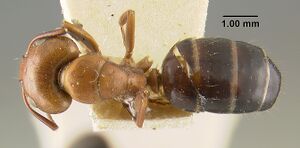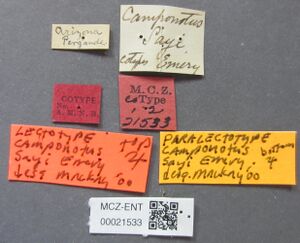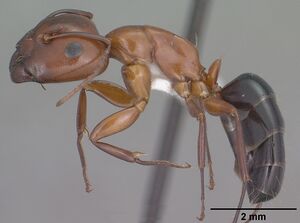Camponotus sayi
| Camponotus sayi | |
|---|---|

| |
| Scientific classification | |
| Kingdom: | Animalia |
| Phylum: | Arthropoda |
| Class: | Insecta |
| Order: | Hymenoptera |
| Family: | Formicidae |
| Subfamily: | Formicinae |
| Tribe: | Camponotini |
| Genus: | Camponotus |
| Species: | C. sayi |
| Binomial name | |
| Camponotus sayi Emery, 1893 | |
In the southwestern part of its range (New Mexico) this species occurs in arid ecosystems where it nests in mesquite (Prosopis spp.) and oaks (Quercus spp.), such as dead limbs (2 - 8 cm diameter) of Quercus arizonica, Q. emoryi and Q. grisea, about 2 meters above soil surface. Dealate females begin nests in such limbs. It is a minor house pest in some areas. Reproductives were found in nests in April. (Mackay and Mackay 2002)
Identification
Major workers of this species have a well defined notch on the anterior border of the clypeus, usually have 2 erect hairs along the basal border of the clypeus, the cheeks and the malar area are without erect hairs, the pronotum is usually without erect hairs, but they may have as many as 4, the dorsum of the mesosoma is very weakly convex, or even straight, the angle of the propodeum is relatively sharp as seen in profile, the petiole is narrow, with sharp apex, the head and mesosoma are usually red, the gaster is black. (Mackay and Mackay 2002)
Keys including this Species
Distribution
Latitudinal Distribution Pattern
Latitudinal Range: 42.69077778° to 23.59°.
| North Temperate |
North Subtropical |
Tropical | South Subtropical |
South Temperate |
- Source: AntMaps
Distribution based on Regional Taxon Lists
Nearctic Region: United States (type locality).
Neotropical Region: Mexico.
Distribution based on AntMaps
Distribution based on AntWeb specimens
Check data from AntWeb
Countries Occupied
| Number of countries occupied by this species based on AntWiki Regional Taxon Lists. In general, fewer countries occupied indicates a narrower range, while more countries indicates a more widespread species. |

|
Estimated Abundance
| Relative abundance based on number of AntMaps records per species (this species within the purple bar). Fewer records (to the left) indicates a less abundant/encountered species while more records (to the right) indicates more abundant/encountered species. |

|
Habitat
In New Mexico (Mackay and Mackay 2002): Chihuahuan Desert, arroyos with hackberry (Celtis), cottonwoods (Populus) in other areas habitats range from prairies to oak-hickory forests, scrubby juniper-pinyon-oak woodland or scrubby ponderosa pine on rocky slopes next to washes, steep, shaded stream banks of seasonal creek valleys with scattered sycamores, walnuts, junipers and large Quercus grisea.
Biology
Nevada, Wheeler and Wheeler (1986) - We have 26 scattered Nevada records from 10 localities. Three records are from the Pinyon-Juniper Biome (but 2 of those are from riparian cottonwood groves). For the remainder no data were given, except that 5 were from houses and 1 under elm bark in Las Vegas and 5 were in houses in Reno. No nests were found.
Castes
Worker
       
| |
| . | Owned by Museum of Comparative Zoology. |
Images from AntWeb
   
| |
| Worker (major/soldier). Specimen code casent0102781. Photographer April Nobile, uploaded by California Academy of Sciences. | Owned by CAS, San Francisco, CA, USA. |
   
| |
| Worker (major/soldier). Specimen code casent0102782. Photographer Jen Fogarty, uploaded by California Academy of Sciences. | Owned by CAS, San Francisco, CA, USA. |
Nomenclature
The following information is derived from Barry Bolton's Online Catalogue of the Ants of the World.
- sayi. Camponotus sayi Emery, 1893i: 679, pl. 22, figs. 27, 28 (s.w.) U.S.A. (Arizona).
- Combination in C. (Camponotus): Forel, 1914a: 266;
- combination in C. (Myrmentoma): Emery, 1920b: 257; Mackay & Mackay, 2018: 24.
- Status as species: Emery, 1896d: 373 (in list); Forel, 1899c: 157; Wheeler, W.M. 1910d: 343 (redescription); Wheeler, W.M. 1910g: 572; Forel, 1914a: 266; Wheeler, W.M. 1917a: 557; Emery, 1925b: 118; Cole, 1937b: 139; Wheeler, G.C. & Wheeler, E.W. 1944: 252; Creighton, 1950a: 389; Smith, M.R. 1951a: 845; Snelling, R.R. 1968b: 355; Hunt & Snelling, 1975: 22; Smith, D.R. 1979: 1432; Snelling, R.R. & George, 1979: 190; Wheeler, G.C. & Wheeler, J. 1986g: 61; Mackay, Lowrie, et al. 1988: 105 (in key); Snelling, R.R. 1988: 72; Deyrup, et al. 1989: 100; Bolton, 1995b: 122; Mackay & Mackay, 2002: 304; Hansen & Klotz, 2005: 92; Ward, 2005: 63; McArthur, 2012: 158, 218.
Unless otherwise noted the text for the remainder of this section is reported from the publication that includes the original description.
Description
Worker
Wheeler (1910) – Major Length, 7-8 mm.; head, 2.5 x 2.4 mm.; scape, 1.7 mm.; hind tibia, 2 mm.
Head large, but little longer than broad, broader behind than in front, with broadly excised posterior margin and prominent posterior corners. Eyes moderately large, feebly convex. Mandibles 5-toothed, convex. Clypeus with very short lateral limbs and subrectangular median portion, which is slightly convex but not carinate, with depressed border and small median notch. Frontal carinae lyrate, rather far apart. Frontal area subtriangular, broader than long. Frontal groove distinct. Antennal scapes short, not reaching the posterior corners of the head, slender and terete at the base, somewhat thickened distally. Thorax stout and short, narrower than the head, robust in front, narrowed and laterally compressed behind; pro- and mesonotum flattened, in profile moderately arcuate; epinotum with subequal base and declivity meeting to form a distinct' though obtuse angle. Petiole high and rather narrow, compressed anteroposteriorly, with convex anterior and flattened posterior surface, its margin entire and rather acute. Legs short, femora stout.
Head and thorax shining, very finely shagreened; cheeks and front with small, round, scattered punctures. Mandibles more coarsely punctate. Gula, sides and posterior corners of head glabrous. Gaster very finely, transversely shagreened, with small, scattered, piligerous punctures, its surface even more shining than the head and thorax.
Hairs white or pale yellow, erect, very sparse; present in a transverse row on the epinotal angle, margin of petiole and in two rows on each gastric segment, one across the middle and the other along the posterior edge. Legs and scapes naked. Pubescence extremely short and dilute, even on the gaster.
Head, antennae, thorax and legs yellowish red; the head slightly darker; gaster black, with the posterior borders of the segments yellow.
Minor Length, 4.5-6 mm.
Head proportionally longer than in the worker major, with straight and more nearly parallel sides, straight posterior border and rounded posterior corners. Clypeus more convex in front, but not carinate, its anterior border with a minute median notch. :Mandibles less convex, eyes more convex than in the worker major, Antennal scapes extending about one-third their length beyond the posterior corners of the head. Thorax less robust; petiole with blunt border.
In sculpture, color and pilosity much like the worker major; head more shining and without small, scattered punctures on the sides and front.
References
- Alatorre-Bracamontes, C.E., Vásquez-Bolaños, M. 2010. Lista comentada de las hormigas (Hymenoptera: Formicidae) del norte de México. Dugesiana 17(1): 9-36.
- Deyrup, M.A., Carlin, N., Trager, J., Umphrey, G. 1988. A review of the ants of the Florida Keys. Florida Entomologist 71: 163-176.
- Emery, C. 1893k. Beiträge zur Kenntniss der nordamerikanischen Ameisenfauna. Zool. Jahrb. Abt. Syst. Geogr. Biol. Tiere 7: 633-682 (page 679, pl. 22, figs. soldier, worker described)
- Emery, C. 1920b. Le genre Camponotus Mayr. Nouvel essai de la subdivision en sous-genres. Rev. Zool. Afr. (Bruss.) 8: 229-260 (page 257, Combination in C. (Myrmentoma))
- Forel, A. 1914a. Le genre Camponotus Mayr et les genres voisins. Rev. Suisse Zool. 22: 257-276 (page 266, Combination in C. (Camponotus))
- Hoey-Chamberlain, R., Rust, M.K., Klotz, J.H. 2013. A review of the biology, ecology and behavior of Velvety Tree Ants of North America. Sociobiology 60(1): 1-10.
- Hoey-Chamberlain, R.V. 2012. Food preference, survivorship, and intraspecific interactions of Velvety Tree Ants. M.S. thesis, University of California, Riverside.
- Mackay, W. P. and E. Mackay. 2002. The ants of New Mexico (Hymenoptera: Formicidae). Edwin Mellen Press, Lewiston, NY.
- Oswalt, D.A. 2007. Nesting and foraging characteristics of the black carpenter ant Camponotus pennsylvanicus DeGeer (Hymenoptera: Formicidae). Ph.D. thesis, Clemson University.
- Snelling, R. R. 1988. Taxonomic notes on Nearctic species of Camponotus, subgenus Myrmentoma (Hymenoptera: Formicidae). Pp. 55-78 in: Trager, J. C. (ed.) Advances in myrmecology. Leiden: E. J. Brill, xxvii + 551 pp.
- Wheeler, G. C. and J. Wheeler. 1986. The ants of Nevada. Natural History Museum of Los Angeles County, Los Angeles.
- Wheeler, W. M. 1910g. The North American ants of the genus Camponotus Mayr. Ann. N. Y. Acad. Sci. 20: 295-354 (page 343, soldier, worker described)
References based on Global Ant Biodiversity Informatics
- Cover S. P., and R. A. Johnson. 20011. Checklist of Arizona Ants. Downloaded on January 7th at http://www.asu.edu/clas/sirgtools/AZants-2011%20updatev2.pdf
- Dash S. T. and L. M. Hooper-Bui. 2008. Species diversity of ants (Hymenoptera: Formicidae) in Louisiana. Conservation Biology and Biodiversity. 101: 1056-1066
- Dattilo W. et al. 2019. MEXICO ANTS: incidence and abundance along the Nearctic-Neotropical interface. Ecology https://doi.org/10.1002/ecy.2944
- Degnan, P.H., A.B. Lazarus, C.D. Brock and J.J. Wernegreen. 2004. Host-Symbiont Stability and Fast Evolutionary Rates in an Ant-Bacterium Association:Cospeciation of Camponotus Species and Their Endosymbionts, Candidatus Blochmannia. Systematic Biology 53(1):95-110
- DuBois M. B. 1981. New records of ants in Kansas, III. State Biological Survey of Kansas. Technical Publications 10: 32-44
- Johnson R. Personnal Database. Accessed on February 5th 2014 at http://www.asu.edu/clas/sirgtools/resources.htm
- Longino, J.T. 2010. Personal Communication. Longino Collection Database
- Mackay W. P., and E. E. Mackay. 2002. The ants of New Mexico (Hymenoptera: Formicidae). Lewiston, New York: Edwin Mellen Press, 400 pp.
- McDonald D. L., D. R. Hoffpauir, and J. L. Cook. 2016. Survey yields seven new Texas county records and documents further spread of Red Imported Fire Ant, Solenopsis invicta Buren. Southwestern Entomologist, 41(4): 913-920.
- O'Keefe S. T., J. L. Cook, T. Dudek, D. F. Wunneburger, M. D. Guzman, R. N. Coulson, and S. B. Vinson. 2000. The Distribution of Texas Ants. The Southwestern Entomologist 22: 1-92.
- Snelling, R.R. 1988. Taxonomic notes on Nearctic species of Camponotus, subgenus Myrmentoma (Hymenoptera: Formicidae). pages 55-XX in J. Trager, editor, Advances in Myrmecology
- Van Pelt, A. 1983. Ants of the Chisos Mountains, Texas (Hymenoptera: Formicidae) . Southwestern Naturalist 28:137-142.
- Vásquez-Bolaños M. 2011. Lista de especies de hormigas (Hymenoptera: Formicidae) para México. Dugesiana 18: 95-133
- Wheeler G. C., and J. Wheeler. 1986. The ants of Nevada. Los Angeles: Natural History Museum of Los Angeles County, vii + 138 pp.
- Wheeler, G.C. and J. Wheeler. 1985. A checklist of Texas ants. Prairie Naturalist 17:49-64.

